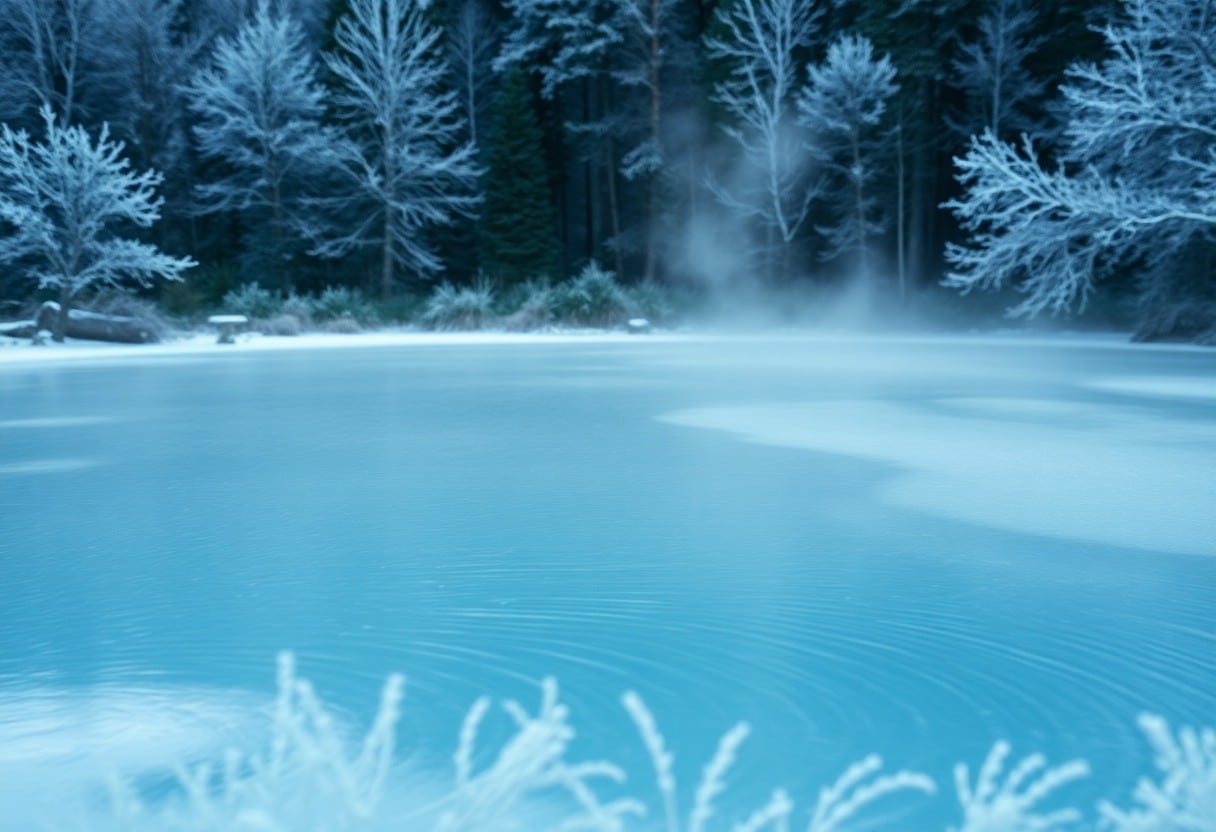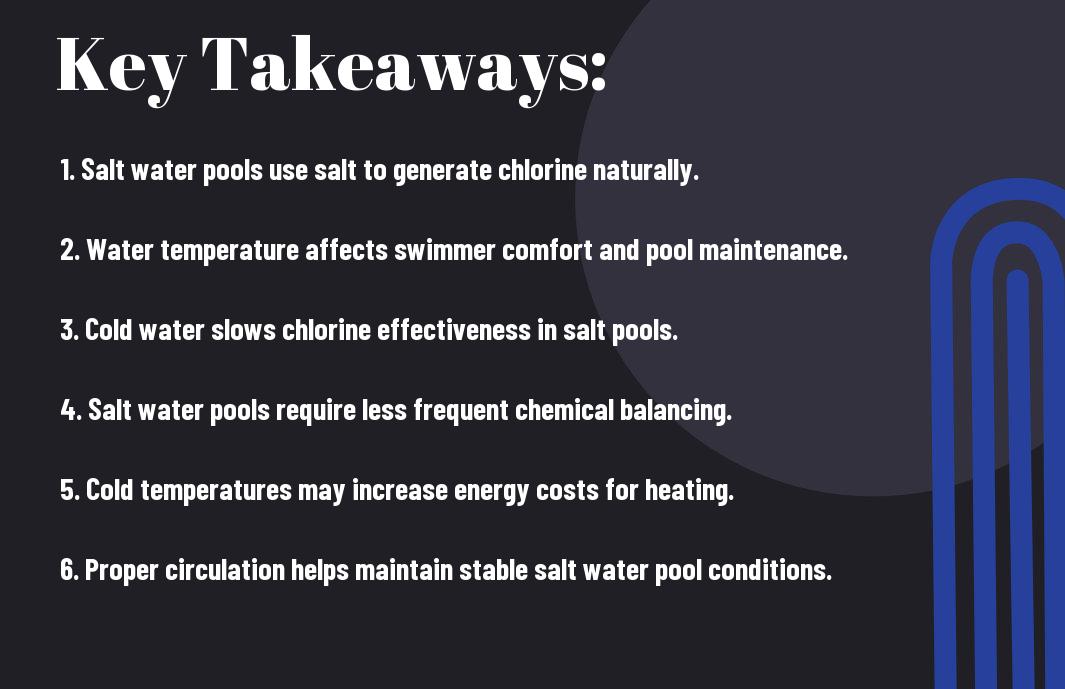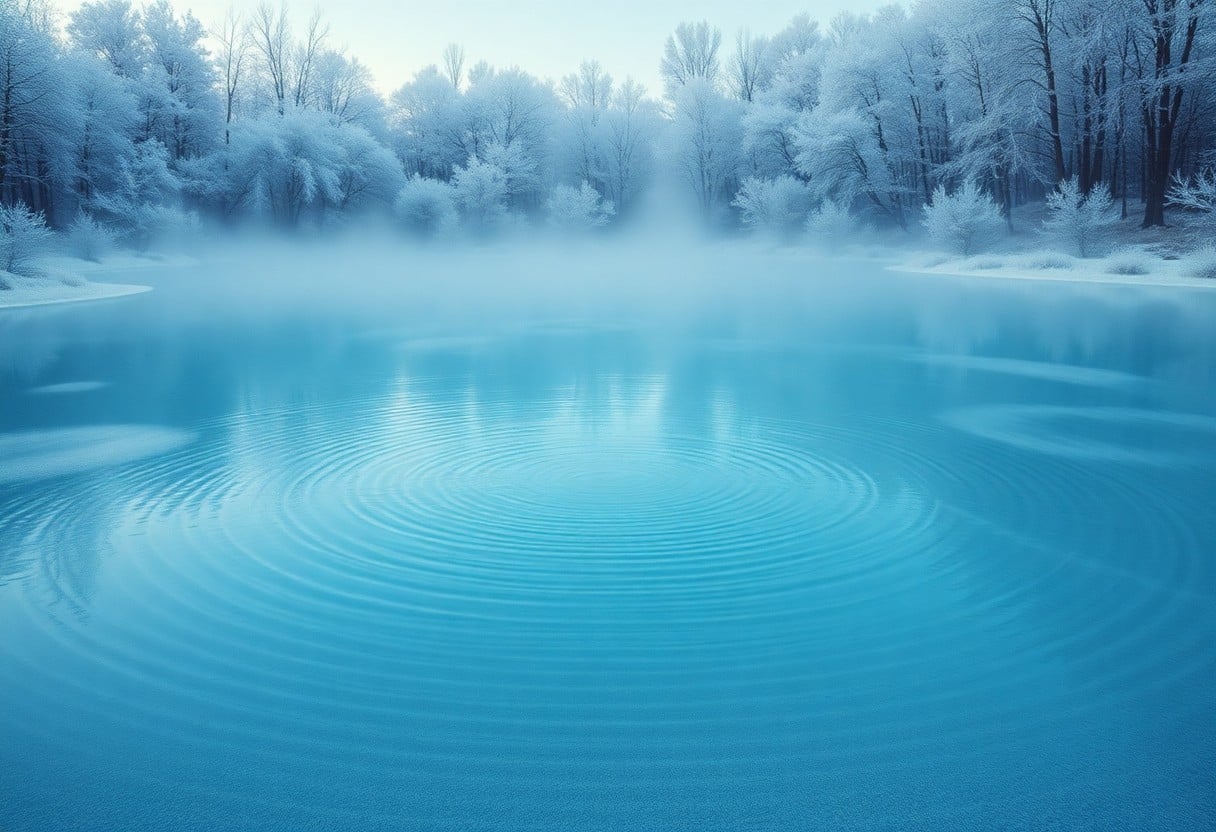Over the years, you may have heard about the benefits of salt water pools, but how do they truly perform during colder temperatures? Understanding the relationship between salt water systems and cool weather is important for maintaining a healthy, sparkling pool year-round. In this post, you’ll learn how salt chlorine generators function in lower temperatures, the effects on water chemistry, and practical tips to keep your swimming environment comfortable even when the temperature drops. By gaining this knowledge, you can optimize your pool care routine and enjoy your outdoor oasis throughout the seasons.

The Chemistry of Salt Water Pools
The unique chemistry of salt water pools revolves around the process of electrolysis. A salt cell, installed in your pool’s filtration system, generates chlorine by passing electricity through the dissolved salt (sodium chloride) in the water. This chlorine serves as the primary sanitizer, effectively combating bacteria and keeping your pool clean. Importantly, the salt concentration in these pools is about one-tenth that of ocean water, which means you enjoy the benefits of salt without the overwhelming brine that can be uncomfortable.
How Salt Water Pools Work
Your salt water pool operates through a salt chlorine generator that converts the dissolved salt into chlorine gas. This chlorine quickly dissolves in the pool water and works to kill harmful pathogens. As the chlorine gets used up, it reverts to salt, making the system efficient and reducing the need for constant chemical additions. Maintaining the appropriate salt levels, typically between 2700–3400 ppm (parts per million), will ensure the system runs smoothly, providing you with a freshly sanitized pool without the harsh effects of traditional chlorine.
Benefits of Salt Chlorination
Salt chlorination enhances your swimming experience by offering several notable advantages. For one, salt water pools tend to have softer water that is gentler on your skin, eyes, and hair, reducing irritation compared to conventional chlorine pools. In addition, you’ll find that maintaining water quality is simpler as the salt cell generates chlorine continuously, which allows for a stable and consistent sanitizer level. Lower maintenance costs and reduced chemical handling make salt water pools increasingly popular among pool owners.
Not only does relying on salt chlorination simplify your pool upkeep, but you also save money in the long run. Traditional chlorine requires regular purchases and handling of potentially hazardous chemicals, which can become costly and inconvenient. With salt chlorination, you only need to invest in salt periodically, and the system self-generates chlorine, allowing for less frequent visits to the store. Moreover, the balanced nature of the water promotes healthier swimming conditions, giving you peace of mind as you enjoy your pool environment without the harshness often associated with standard chlorinated water.


Battling the Cold: Temperature Effects on Salt Water Pools
Dealing with cold temperatures can pose unique challenges for your salt water pool. Low temperatures can impact your pool’s chemistry, equipment performance, and overall maintenance routines. Understanding these effects will help you take the necessary precautions to maintain a balanced and functional pool environment, even when the temperatures drop.
Impact of Low Temperatures
| Effect | Description |
|---|---|
| Reduced chlorine production | Chlorine generation from the salt cell decreases, leading to potential algae growth. |
| Increased water viscosity | Colder water can complicate circulation and filtration efficiency. |
| Equipment strain | Low temps can put excessive strain on pumps and heaters, leading to potential breakdowns. |
The Impact of Low Temperatures
As temperatures plummet, the efficiency of your salt cell declines significantly, producing less chlorine and necessitating close monitoring. This reduction can allow algae and bacteria to thrive in your pool. Moreover, the viscosity of water increases, which impacts circulation and filtration—making it more difficult to maintain water quality. Additionally, equipment may work harder to maintain proper temperatures and flow rates, raising the risk of wearing out pumps and heaters sooner than expected.
Day-to-Day Maintenance Adjustments
Adjusting your daily maintenance routine becomes important when facing cooler temperatures. You may find that regular checks on chlorine levels and water balance are necessary as the effectiveness of your existing chemicals changes. Additionally, considering heater settings or utilizing pool covers can help retain heat and minimize energy costs during colder weather.
Day-to-day maintenance in colder climates requires vigilance. Regularly test your water chemistry and adjust your salt and pH levels to ensure optimal performance. It’s advisable to run the pump and heater for longer periods to maintain circulation and prevent freezing in the system. Moreover, covering your pool during nights can help trap heat and minimize heat loss. Adapting these routines allows your salt water pool to stay efficient and functional, even in chillier months.
Health and Comfort: Cold Water Swimming
Cold water swimming offers unique health benefits, appealing to enthusiasts seeking both physical and mental rewards. Immersing yourself in chilly water can invigorate the body, improve circulation, and enhance your mood. Many swimmers report a rush of endorphins, leading to reduced anxiety and increased feelings of well-being. Additionally, cold water may boost your immune system, making it easier for your body to fend off illnesses.
Benefits of Cold Water Exposure
Engaging in cold water exposure can provide numerous benefits, such as enhanced recovery after exercise, improved circulation, and increased alertness. Your body also adapts better to stress, both physically and mentally, as it learns to handle the shock of temperature fluctuations. This adaptation may lead to improved resilience and an overall heightened sense of vitality.
Risks to Consider
While cold water swimming can be exhilarating, certain risks should be acknowledged. Hypothermia, cold shock response, and other health concerns may arise, especially if you’re not properly acclimated to lower temperatures. Understanding these dangers ensures that your experience remains not only enjoyable but also safe.
Hypothermia can set in when body temperature drops significantly, particularly when swimming in water below 60°F (15.6°C). Cold shock response often manifests as gasping or rapid breathing, which can lead to panic or disorientation if you aren’t prepared. To mitigate risks, familiarize yourself with cold water capabilities, gradually acclimatize to lower temperatures, and be mindful of weather conditions before entering the water. Always swim with a buddy, and consider wearing a wetsuit to maintain body warmth, enhancing safety alongside enjoyment.
Maximizing Seasonality: Strategies for Cold Weather
To fully enjoy your salt water pool during the colder months, implementing smart strategies can extend your swimming season. By optimizing heating solutions and utilizing effective pool covers, you can create a comfortable and enjoyable aquatic experience despite chilly temperatures. Preparing your pool for cold weather not only enhances your swimming experience but also helps maintain the quality of your water and equipment.
Effective Heating Solutions
Investing in efficient heating solutions can make a significant difference in your cold weather swimming experience. Options such as heat pumps or solar heaters provide a cost-effective means of maintaining a comfortable water temperature, allowing you to swim even when the temperatures drop. Heat pumps, for instance, can warm the water by extracting heat from the air, making them an eco-friendly choice.
Covering Your Pool: Best Practices
Properly covering your pool serves as an efficient way to retain heat and reduce energy costs. A high-quality pool cover can minimize evaporation, insulate the water, and protect your pool from debris. Consider investing in an automatic or thermal cover, which provides excellent insulation and can be easily deployed when needed.
A solar cover is another effective choice for maintaining warmth while enhancing water circulation. These covers utilize sunlight to naturally heat the water, while reducing heat loss during cooler nights. Opt for a cover that fits snugly to your pool’s dimensions, ensuring minimal gaps where cold air can enter. Regularly inspect your cover for wear and tear, and keep it clean to maximize its performance and longevity. By prioritizing these best practices, you’ll create an inviting swimming environment that can be enjoyed throughout the colder months.
Environmental Perspectives: Energy Consumption and Sustainability
Understanding the energy demands of salt water pools, especially in cold temperatures, can inform better choices for maintaining environmental sustainability. With a critical eye on the energy required to heat pools during colder months, it’s possible to explore more efficient methods and technologies that minimize ecological impact while still enjoying your swimming experience.
Analyzing Energy Use in Cold Temperatures
| Heating Systems | Electric, gas, and solar options vary in efficiency and environmental impact. |
| Pool Size | Larger pools generally require more energy to heat, affecting overall consumption. |
| Insulation Quality | Proper insulation can significantly reduce heat loss, leading to less energy use. |
| Weather Conditions | Cold, windy days lead to increased heat loss, demanding more energy to maintain temperature. |
Salt Water Pools and Eco-Friendliness
Salt water pools present a more eco-friendly alternative to traditional chlorinated pools, largely because they use a salt chlorinator reducing reliance on harsh chemicals. This system generates chlorine on-site, minimizing chemical transport and packaging waste. Moreover, the salt is less harmful to your skin and the surrounding environment, leading to a healthier aquatic ecosystem during use.
In addition to reducing chemical use, salt water pools often require lower levels of maintenance. By utilizing a natural sanitization process, these pools may save you time and resources spent on balancing traditional pool chemicals, generating less waste in the long run. This reduced maintenance can also contribute to energy savings, as the need for additional equipment or chemical dispensers is lessened. Overall, the eco-friendliness of salt water pools underscores their appeal for environmentally conscious pool owners seeking effective yet sustainable solutions for their outdoor enjoyment.
To wrap up
With these considerations, you can enhance your experience with saltwater pools, especially in colder temperatures. Understanding how temperature affects your pool’s chlorination process and water chemistry will help you maintain optimal pool conditions. By adjusting your maintenance routines and being prepared for the unique challenges that cold weather brings, you can enjoy a clean and inviting pool all year round. This knowledge empowers you to make informed decisions, ensuring your pool remains a source of enjoyment regardless of the season.
